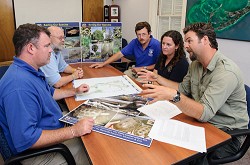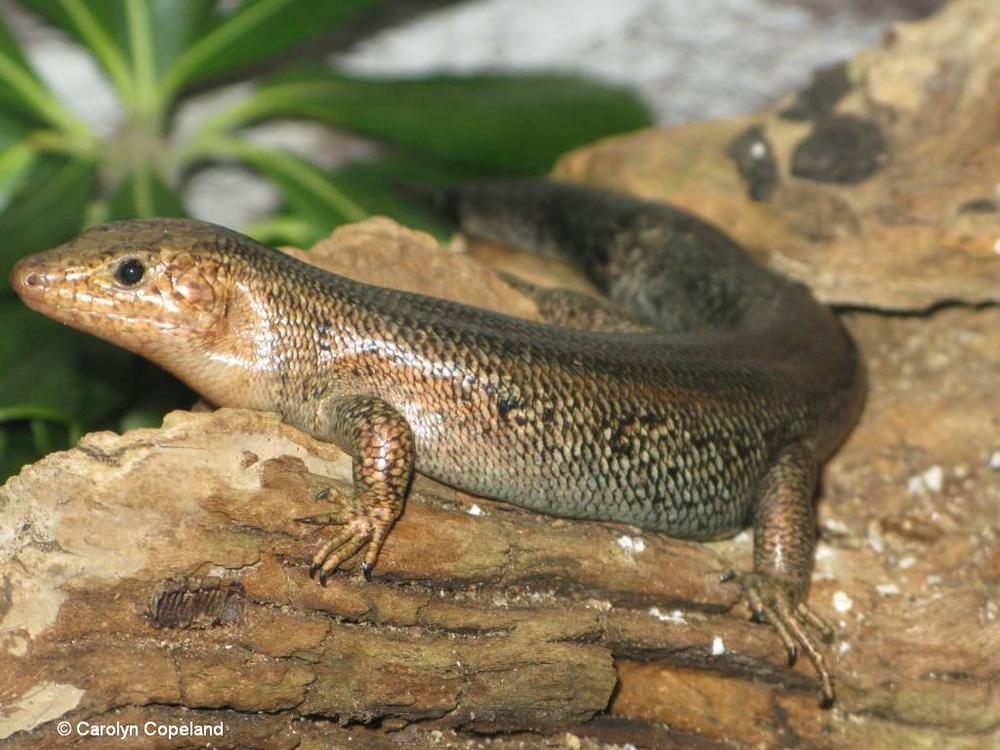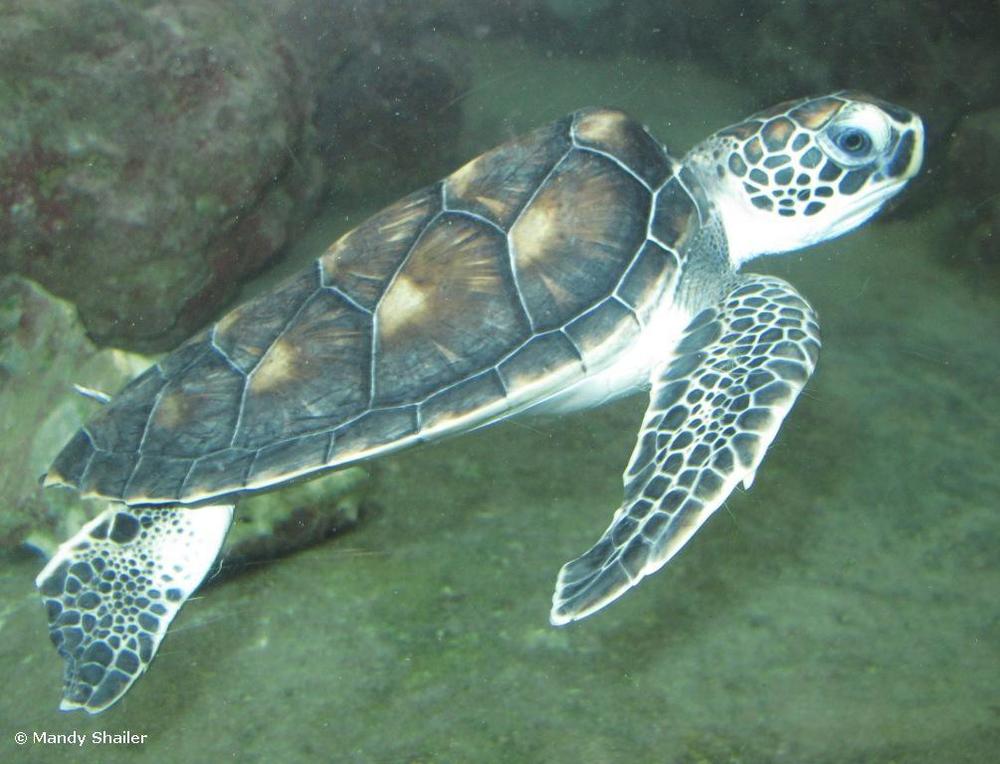Simon Jones
The Bermuda Sun News
WEDNESDAY, APRIL 25:
This September, six pairs of Bermuda skinks will be collected from one of their last strongholds in Castle Green team: The conservationists behind Bermuda’s Lifeboat Projects (clockwise from left) Drew Pettit, Director of Conservation Services; Dr Robbie Smith, curator at the Natural History Museum; Robin Marirea, head zoo keeper; Alison Copeland, biodiversity officer and Mark Outerbridge, researcher for the Bermuda Zoological Society. *Photo by Kageaki Smith Harbour.
Green team: The conservationists behind Bermuda’s Lifeboat Projects (clockwise from left) Drew Pettit, Director of Conservation Services; Dr Robbie Smith, curator at the Natural History Museum; Robin Marirea, head zoo keeper; Alison Copeland, biodiversity officer and Mark Outerbridge, researcher for the Bermuda Zoological Society. *Photo by Kageaki Smith Harbour.
The critically endangered rock lizards will be carefully loaded onto a plane and flown to Chester Zoo in the UK.
Their mission is simple: to secure the future of Bermuda’s only indigenous land vertebrate.
The Bermuda skink project is the latest in a series of ‘Lifeboat’ initiatives organized by conservationists in Bermuda to safeguard the island’s rarest and most endangered species.
Over the past 10 years it has seen killifish sent to the Vienna Zoological Gardens, Bermuda land snails sent to London Zoo and the Governor Laffan fern sent to Henry Doorly Zoo in Omaha.
This work has helped to create ‘repositories’ of Bermudian species on the brink of extinction across the globe.
And it means they could be brought back to Bermuda if the natural population died out.
Drew Pettit, Director of Conservation Services, said: “Bermuda is one of the remotest oceanic islands in the world.
“As a result we have had quite a few endemic species ranging from insects, marine animals through to birds and reptiles.
Vulnerable
“We should have more endemics, given our age and isolation but we believe a series of sea level fluctuations through the ages has stemmed some of this evolution.
“Regardless of that, we are particularly vulnerable due to physical isolation and having all our eggs in one basket.”
In the past there have been many recorded extinctions of plants and animals in Bermuda due to loss of habitat, climate change, disease and the introduction of pests such as rats.
Mr Pettit added: “We know through fossils, historical documents and recorded observations that Bermuda used to have fireflies, an endemic flightless grasshopper, an endemic duck, an endemic crane, an endemic hawk as well as an endemic land tortoise — which disappeared some 300,000 years ago.
“We also used to have four types of endemic snail, while now we only have one.
“Fossils of a short tailed albatross are found on Green Island, Coopers Island and other dunes along South Shore.”
The Department of Conservation Services, together with the Bermuda Aquarium, Museum and Zoo and its small team of Conservation Officers, has been working on developing ‘recovery plans’ and Lifeboat Projects since 2002.
There are currently five different projects ongoing, at varying stages in Bermuda.
Mr Pettit told the Sun: “A lifeboat can be defined as a small boat kept on a ship for use in an Rare: The latest Lifeboat Project will see a number of critically endangered Bermuda skinks collected from Castle Harbour and flown to Chester Zoo in the UK to help secure their future. emergency.
Rare: The latest Lifeboat Project will see a number of critically endangered Bermuda skinks collected from Castle Harbour and flown to Chester Zoo in the UK to help secure their future. emergency.
“This same philosophy is being used for the conservation of our unique and threatened species.
“While every effort is being made to safeguard the species that make Bermuda unique, we are using a precautionary strategy to relocate or export small populations of our threatened species to less vulnerable areas or institutions.
“Our first priority is to ensure the survival of endemic species, which are unique to Bermuda.
“Once they are gone they are gone, as they are found nowhere else in the world. You can’t just bring in a new batch to restock the shelves.”
Conservationists work at both a local and an international level to help protect the island’s most endangered species.
Mr Pettit added: “On a local level – we transplant or relocate small populations from one particularly vulnerable area to other areas in order to increase the island range by spreading the risk out across the island.
High risk
“The Department has found that many of our endemic species have now been pushed into only a couple of places which are at high risk of failure.
“A good example is the endemic Lover’s Lake Killifish which until recently survived in only one pond.
“Now populations have been trans-located to two other ponds to safeguard their survival.
“On an international level we also work with international Zoos and Botanical Gardens who are willing to help us preserve and breed these species.
“In return they get to display in their institutions some of the rarest species in the world.
“So working with other international agencies Bermuda, at no cost to the island, has been able to save small populations of species for the future.”
“Our endemic species make us unique to the rest of the world and by preserving our unique species we combat a growing trend in the decline the world’s biodiversity which is seeing the disappearance of large numbers of species.”
The next chapter in the ongoing battle to save Bermuda’s unique population begins with the departure of the Bermuda skinks later this year.
It is estimated that there are less than 5,000 of these critically endangered species in Bermuda today.
They are found only on islets in Castle Harbour and there are a few fragmented populations along South Shore.
The kink is Bermuda’s only endemic terrestrial vertebrate. Its future survival will depend heavily on the six rock lizards heading across the Atlantic Ocean.
Mr Pettit added: “Our head zoo keeper has already visited the facilities at Chester Zoo with the help of an international grant.
“Once they are established we will periodically send over more Skinks to broaden their genetic diversity.
“We hope that this lifeboat project will prove successful, as others before it have.”
If you think you have seen any of the species listed in this article email conservation@gov.bm or visit www.conservation.bm to leave a message.



